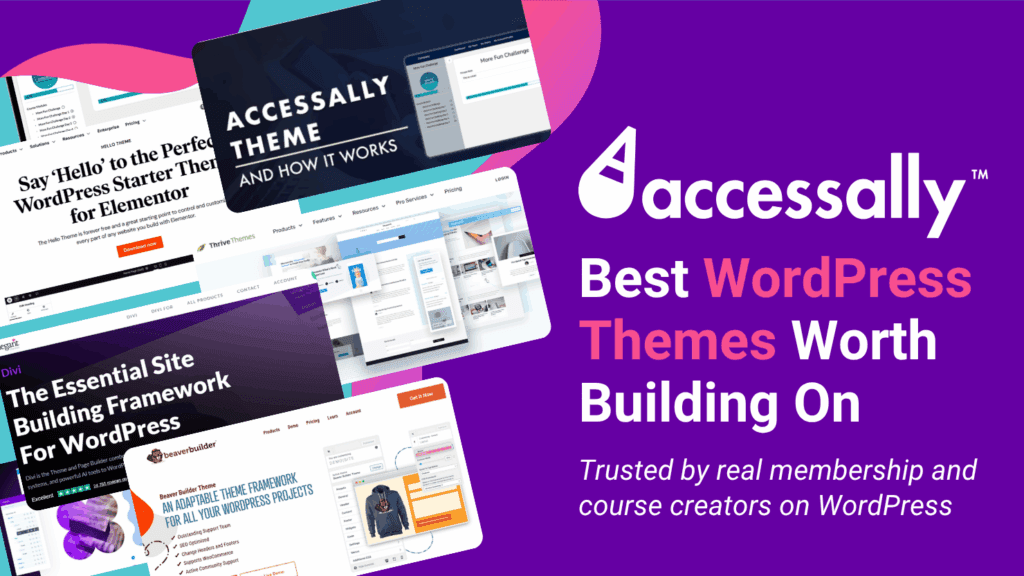Looking for the best WordPress themes? These 5 favorites are tried and tested by coaches, course creators, and AccessAlly users building online businesses.
When I first dipped my toes into the world of WordPress, I remember feeling both excited and completely overwhelmed. There were endless settings to explore, plugins to install, but the most intimidating of all: thousands of WordPress themes to choose from.
With so many themes out there, it can feel overwhelming to know where to start. That’s why I took a closer look at what’s actually working for AccessAlly users right now.
In this post, I’m highlighting the 5 best WordPress themes most commonly chosen by our community. These aren’t just themes that could work with AccessAlly—they’re the ones real course creators, coaches, and membership site owners are actively using to run their businesses every day.
What I Look for in a WordPress Theme
After building a few different sites, I realized the theme isn’t just “the pretty part” of your site—but the best WordPress themes act as the foundation. The wrong one can leave you stuck with slow load times, clunky layouts, or features that don’t grow with you.
That’s why I take theme selection seriously now. I’m not swayed by flashy demos or trendy fonts—I want something that actually supports my site long-term. Over time, I’ve learned to look past surface-level design and focus on whether a theme is dependable, flexible, and easy to work with.
Here’s what I always check for:
- Lightweight and fast – I avoid themes loaded with unnecessary features or “theme bloat.” A lightweight theme keeps my site running smoothly, which is especially important if I don’t want to waste time or budget fixing speed issues later.
- Mobile responsiveness – Most of my visitors come from their phones, so I need a theme that looks just as polished on a mobile screen as it does on a laptop.
- SEO-friendly structure – A clean, well-coded theme makes it easier for search engines to understand my site, which helps me get discovered faster.
- Customization options – I want the freedom to tweak colors, fonts, and layouts without touching code. That way my site feels like mine from the very beginning.
- Regular updates and support – Even a free theme should be maintained by its developers. I don’t risk using something outdated that could break my site or create security issues.
- Plugin compatibility – Since I often use tools like WooCommerce, I stick with themes that play nicely with major plugins. It saves me headaches as my site grows.
This checklist has saved me from a lot of frustration—and given me themes that not only look good but also hold up as my site evolves.
What’s the Difference Between a WordPress Theme vs WordPress Page Builder
When I first started digging into WordPress, one thing that tripped me up was the overlap between themes and page builders. Some tools branded themselves as one, others as the other, and a few claimed to be both. It’s no wonder the lines get blurry!
The truth is, they’re not interchangeable—they serve different roles but often work best together. Before diving into the top themes, here’s a quick comparison to clear up what each one does and why it matters:
| WordPress Theme | WordPress Page Builder |
| The design template for your entire site—controls layout, colors, fonts, headers/footers, and default page styles. | A tool for designing and arranging content inside pages with drag-and-drop (text, images, buttons, sections, etc.). |
| Can be minimal “blank canvases” or come with ready-made layouts and demo pages. | Lets you build pages however you want, not limited to theme defaults. |
| Sets global structure—typography, colors, archives, menus, templates. | Adds flexibility with visual editing—rows, columns, widgets, content blocks, and more. |
Why Some Tools Are Both
Some platforms package both a theme and a page builder into one system, and that can be a big advantage.
Instead of using a theme for your site’s structure and a builder for your page layouts, these all-in-one tools let you handle everything—headers, footers, blog templates, and pages—inside the same drag-and-drop editor.
In setups like this, the builder essentially is the theme, which makes the setup simpler and gives you full control from the start. It’s why many people consider these all-in-one setups among the best WordPress themes for creators who want everything in one place.
My Picks for the 5 Best WordPress Themes (Trusted by AccessAlly Users Too!)
Over the years, I’ve tested more themes than I can count—but instead of relying only on my own experience, I also did some asking around within our AccessAlly community too. I wanted to know what membership site and course creators are using right now.
A handful of themes consistently rose to the top as the best WordPress themes among AccessAlly users. These themes strike the right balance between flexibility and stability—they’re easy enough for beginners to set up but powerful enough to grow with you as your business scales.
Here are the 5 themes that stood out as the most popular (and most trusted) among our users.
1. The AccessAlly Theme
The first theme on my list is no surprise: the AccessAlly Theme. Built by the same people behind AccessAlly, it doesn’t just “work with” the platform—it runs alongside it, supporting everything I set up inside AccessAlly.
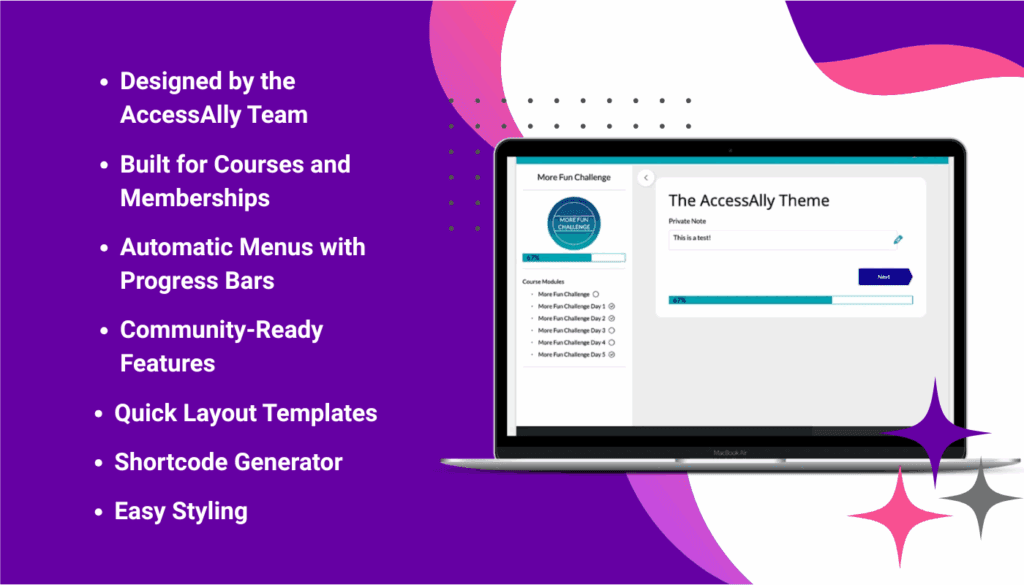

From the moment you activate the theme, your site feels like it’s ready for courses, memberships, and communities. Navigation menus sync directly with your offerings, dashboards display progress in real time, and lesson layouts already feel organized.
When you add or reorder lessons, the theme updates the menus and progress tracking instantly, keeping everything in step with your content. You’re not piecing things together—the theme just knows what you’re trying to build!
The theme also makes it easy to bring AccessAlly elements into your pages. With the built-in Shortcode Generator, you can place quizzes, order forms, and progress indicators exactly where you want them.
And while it handles so much for you, it’s not limiting. In the Customizer, you can update fonts, colors, headers, and layouts just like you would with any other WordPress theme. One of my favorite perks here is, you can enable your AccessAlly brand colors inside the Customizer, syncing the design across your entire site without having to re-enter them.
👉 Discover More about the AccessAlly Theme
TLDR: Reasons Why I Love the AccessAlly Theme
- Built for courses and memberships: Since it was designed by the same team behind AccessAlly, everything—from my course dashboards to member navigation—just clicks into place without me needing to patch things together.
- Automatic menus with progress bars: The moment I add a new lesson or module, the sidebar menu and progress bar update themselves.
- Community-ready features: I love that CommunityAlly notifications show up right inside member dashboards. It makes updates feel natural, like part of the flow instead of something bolted on.
- Quick layout templates: Sometimes I need a simple page, other times I want a sidebar in place. Having three page templates (default, no sidebar, static sidebar) ready to go saves me so much decision fatigue.
- Shortcode generator: Whether it’s a quiz, an order form, or a progress bar, I can drop AccessAlly elements anywhere with a shortcode. It keeps my site feeling consistent without me having to fuss with code.
- Easy styling: I set my brand colors once in AccessAlly, and when I enable them in the Customizer, the theme picks them up everywhere. My site looks on-brand instantly, and if I need to go deeper, the child theme keeps my custom CSS safe through updates.
👇Demo the AccessAlly Theme Below 👇
2. Hello by Elementor
The Hello Theme is Elementor’s own “blank canvas,” built to fit like a glove with their page builder. It’s free, feather-light, and designed to give you total control over how your site looks and functions.
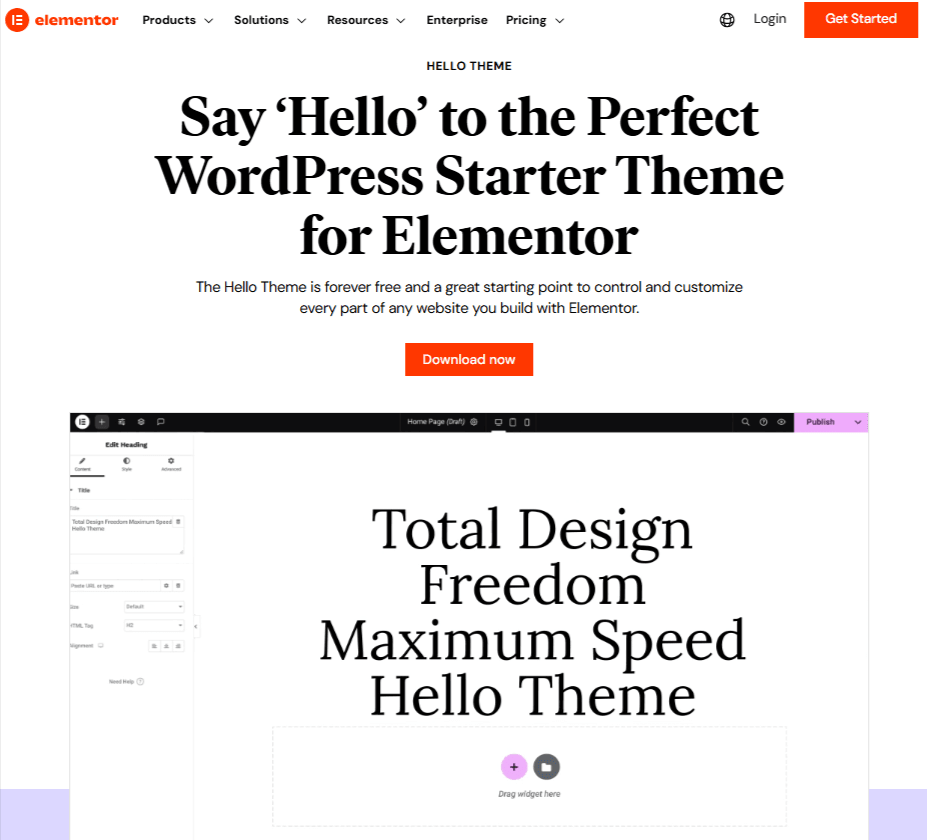

Out of the box, Hello doesn’t come with heavy styling or complex templates. But it’s not bare bones either—it still supports all the WordPress essentials like customizable fonts, headers and footers, logo placement, and even advanced touches like color-changing headers.
That stripped-back approach is also what makes it powerful. Hello loads in under a quarter of a second and requires only about 6 KB of resources, making it significantly leaner than most WordPress themes.
For users who want a head start, Elementor recently introduced Hello Biz, a beginner-friendly version that comes with 8 pre-designed kits, quick header and footer setup, and purpose-built Hello widgets—also free, and all designed to help you launch a professional-looking site in minutes.
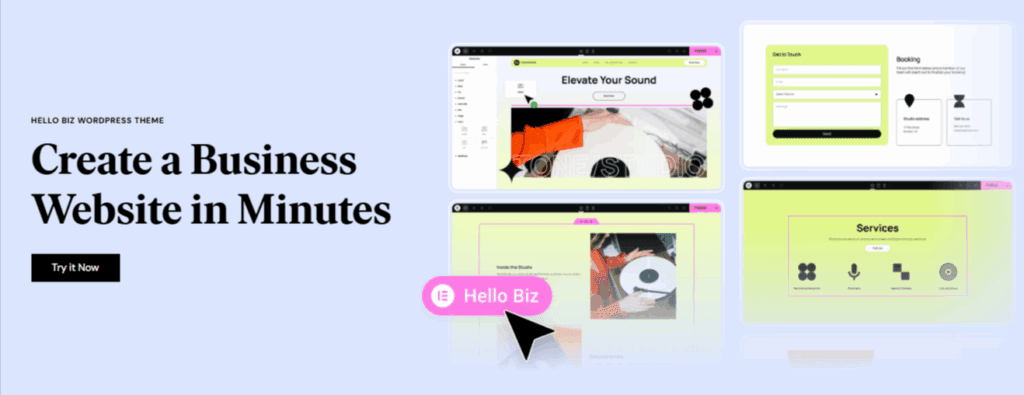

Hello is ideal if you want Elementor to handle the entire look and feel of your site. But here’s where the distinction matters: the theme itself stays minimal by design, while the full creative power comes from Elementor Pro’s Theme Builder.
Pairing Hello with Pro unlocks the ability to design headers, footers, dashboards, and dynamic layouts. It also opens up powerful WooCommerce site-building features—so you can customize product pages, shop layouts, and checkout experiences with the same drag-and-drop ease.
For anyone running an online store, that combination easily earns the Elementor name a place among the best WordPress themes for WooCommerce.
3. Beaver Builder
Beaver Builder is a reputable page builder plugin for WordPress, and the flagship tool most people think of when they hear the name. Alongside the plugin, the team also offers two companion tools that complete the site-building workflow: the Beaver Builder Theme and the Beaver Themer add-on.
Like Hello, the Beaver Builder Theme gives you a clean foundation instead of a pre-packaged design. You still get the essentials—colors, fonts, headers, footers, and menus—but everything lives inside the WordPress Customizer, so you can see your changes in real time. That’s a big perk in my book!
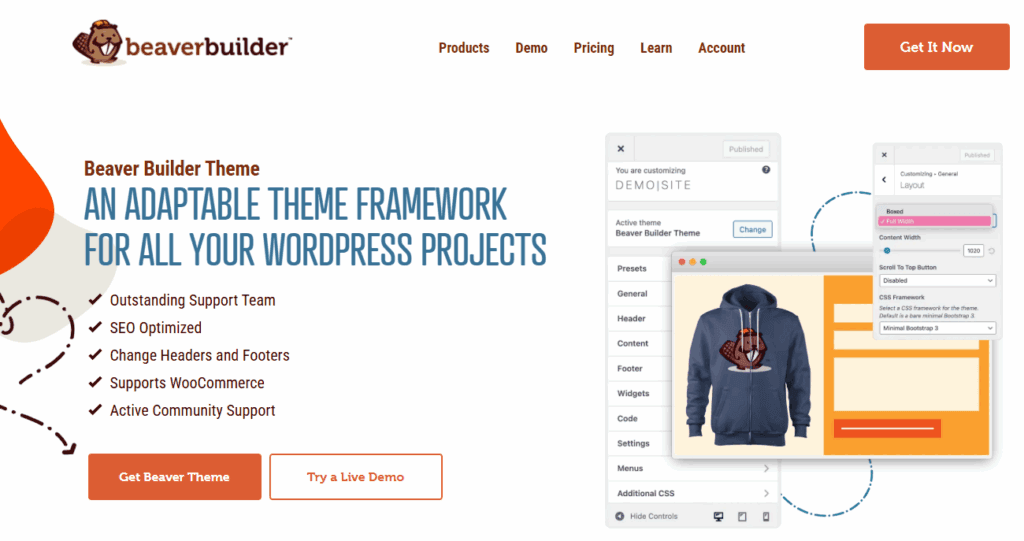

The Beaver Themer add-on is where things get really interesting. It extends Beaver Builder beyond the usual content area and gives you full control over the parts of a site that normally belong to the theme—one of the reasons it’s often considered among the best WordPress themes for advanced customization.
Want to design custom headers, footers, archive pages, or 404 templates? You can. Need to overhaul WooCommerce pages—like the shop, checkout, or account areas? Themer handles those too. It even lets you build reusable “parts,” like announcement bars, CTAs, or custom rows, and place them across all or just some of your pages.
Themer also supports dynamic data connections, so instead of dropping in static text or images, you can pull content directly from WordPress fields, Custom Post Types, or even tools like ACF, Pods, or MetaBox. That makes it incredibly powerful if you’re building more advanced sites, because you’re not limited to what’s hardcoded—you’re designing layouts that flex with your content.
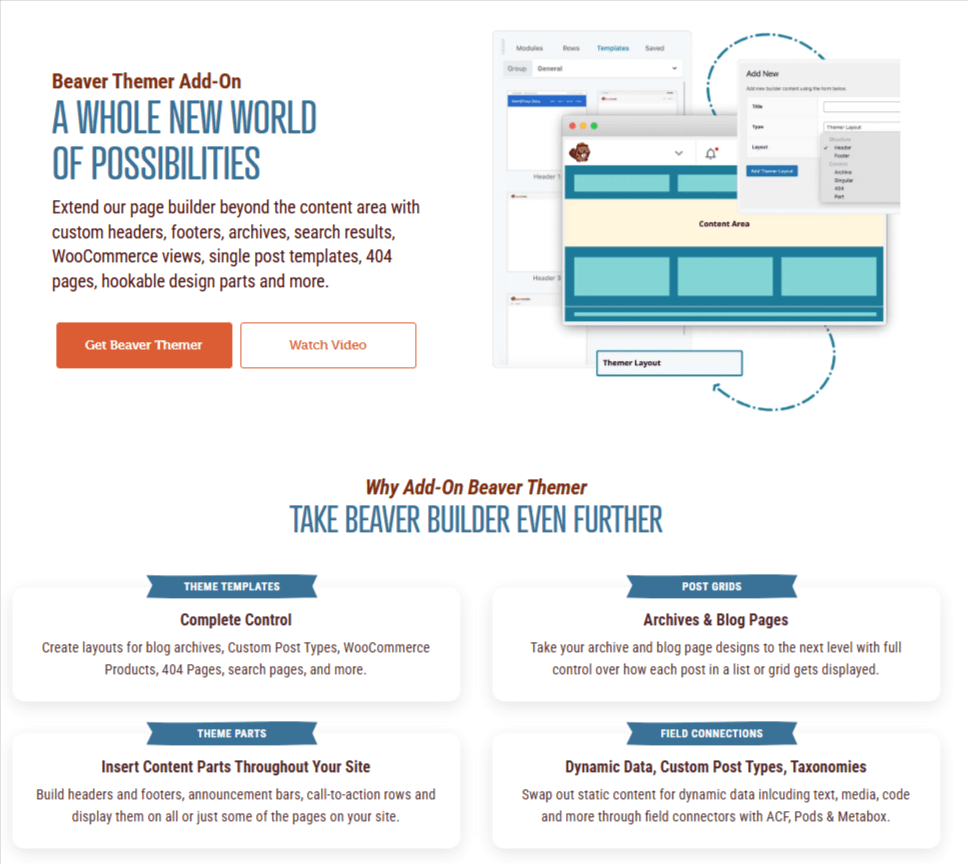

Whew—that was a lot of tech talk, but it makes sense. Beaver Builder is intentionally developer-friendly, built to be extended, customized, and reused across projects. That’s also why their plan structure works the way it does: the unlimited plan is a huge win for agencies or client work, since it lets you activate the theme across as many sites as you need.
Another standout is Beaver Builder’s community support. I was genuinely impressed by the range of resources available: a blog full of tutorials, an active Facebook group, a Slack channel, community forums, and even a Discord server. There’s a sense that if you run into a question, you’ll never be stuck on your own.
4. Divi
Right off the bat, I was blown away by the Divi Theme the moment I landed on its homepage… and not just because my favorite color is purple 💜 Scrolling through felt like a preview of everything it brings to the table and the differences it offers compared to some of the themes we’ve covered so far.
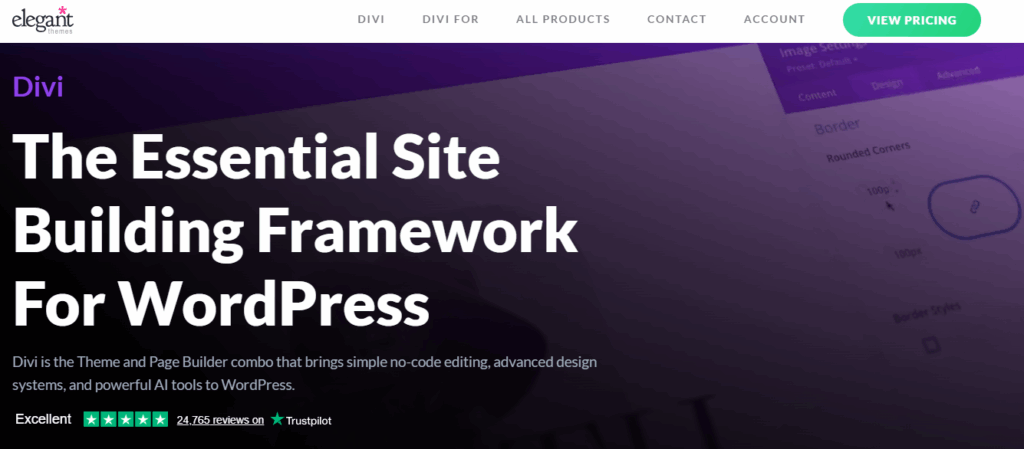

Divi is a full WordPress theme and visual builder in one package, built by Elegant Themes. When you install Divi, you’re getting both the theme and the builder—no extra plugins required.
While you can use the Divi Builder with other themes, most people stick with the full Divi Theme because they’re designed to work together seamlessly.
Circling back to what grabbed me on the homepage, here are some standout features:
- Starter Sites – Fully customizable starter sites with pages, templates, and global styles—get a complete website in minutes, then refine it to match your brand.
- Divi AI – Your built-in creative partner that designs layouts, generates copy and images, and handles coding customizations—making it faster and easier to bring your ideas to life.
- Advanced Display Conditions – Control how and when content appears based on user behavior, from logged-in status to specific actions, for a more personalized experience.
- Animated Scroll Effects – Add interaction and movement to your pages with scroll-based animations that fade, move, or transform elements as visitors browse.
- Divi Cloud – Every layout, template, or snippet you create can be saved to the cloud, so you can reuse them on any new site. For freelancers and agencies, it’s a serious time-saver—your design library follows you everywhere!
Divi ranks among the best WordPress themes thanks to its balance of power and ease of use. Beginners can stick with drag-and-drop editing, while developers have room to layer in custom CSS, snippets, and advanced tweaks.
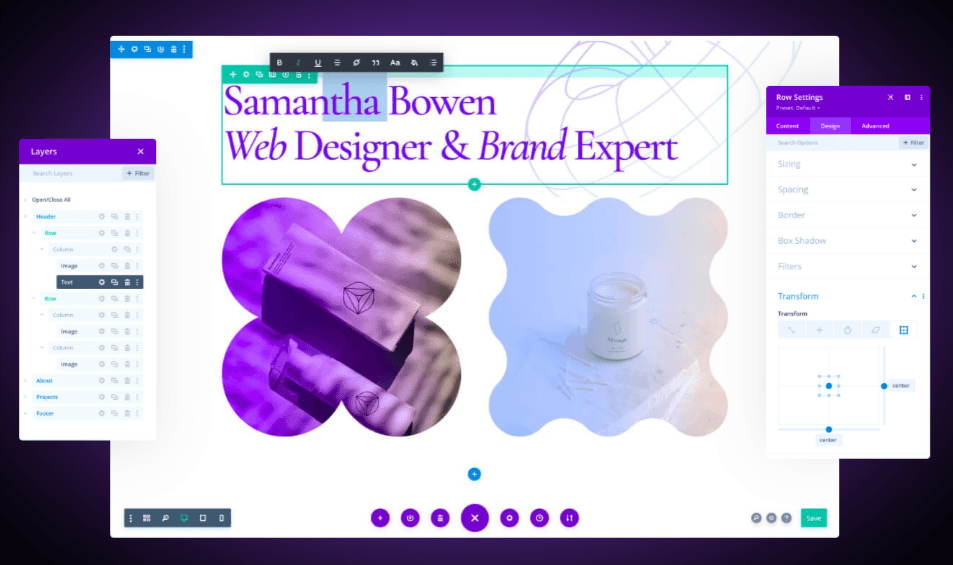

In short, Divi is one of the rare WordPress builders that truly covers the full spectrum—from DIY site owners to advanced developers—without forcing you into one box.
5. Thrive
Thrive Theme Builder takes a different angle from the other options we’ve covered. It’s not technically a theme at all—it’s a theme builder. Instead of handing you a fixed design to work within, it gives you the tools to visually build your own WordPress theme from the ground up.
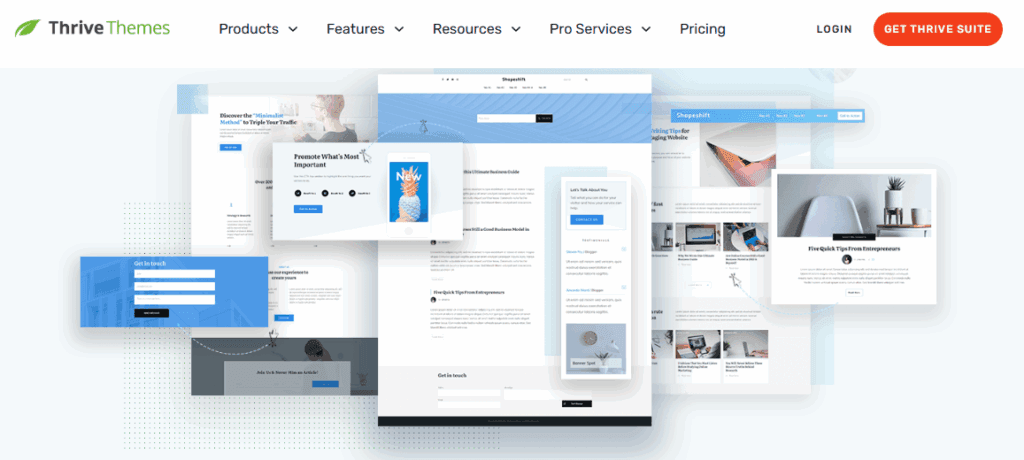

If the idea of “starting from scratch” sounds intimidating, don’t fret. Thrive comes with a full library of companion themes that act like ready-made blueprints. You can launch something polished in minutes, then tweak and refine until it feels like your own.
Thrive’s conversion-first mindset is what makes it stand out as one of the best WordPress themes for marketers. Beyond the Theme Builder itself, you see this focus across the rest of the Thrive Suite—tools built specifically to help you grow your list, increase engagement, and drive sales:
- Thrive Architect – A visual page builder with conversion-focused elements like countdown timers, opt-in forms, and pricing tables.
- Thrive Leads – Advanced opt-in form builder with targeting, triggers, and analytics to grow your email list faster.
- Thrive Comments – Turns your WordPress comments into an engagement tool with gamification, upvotes, and user actions.
- Thrive Optimize – Built-in A/B split testing for landing pages so you can see which designs and copy drive the best results.
- Thrive Ovation – Streamlines collecting, managing, and displaying testimonials to build trust and social proof.
- Thrive Ultimatum – Evergreen and fixed-date countdown campaigns designed to add urgency and boost conversions.
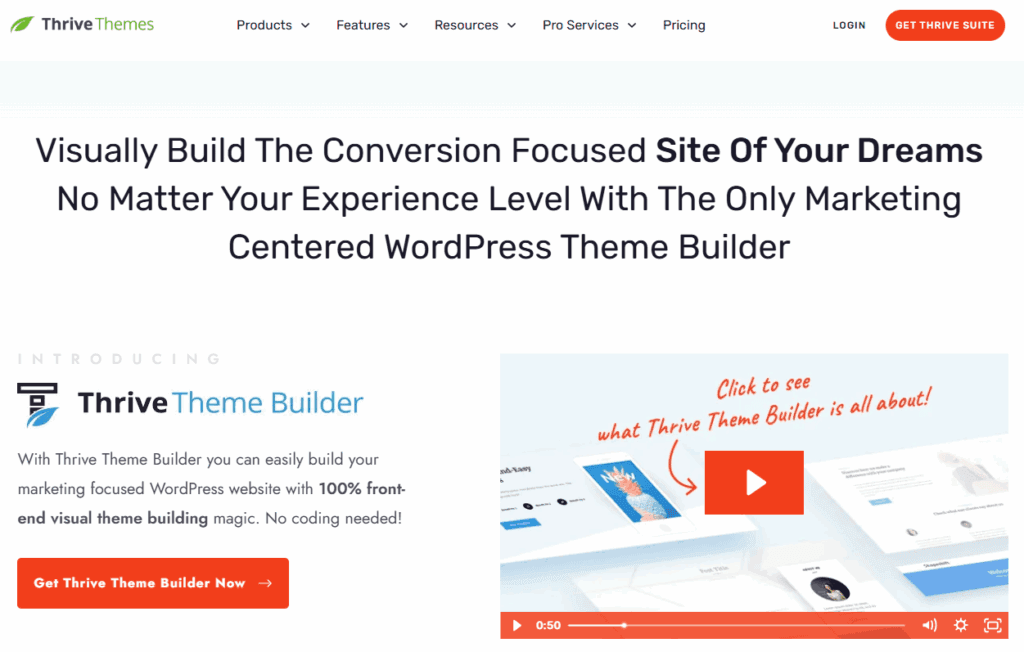

And here’s a rare perk: Thrive Pro Services. If you don’t have the time or desire to set everything up yourself, you can hire their in-house team to design, build, or even maintain your site. That’s not something you’ll find with most other builders in this roundup.
Conclusion
At the end of the day, the best WordPress themes aren’t just the ones with the most features—it’s the one that fits the way you’re building your business website.
That’s why I wanted to highlight the 5 best WordPress themes that real AccessAlly users are leaning on most right now: AccessAlly Theme, Hello by Elementor, Beaver Builder, Divi, and Thrive.
Each one takes a slightly different angle, but they all share the same bottom line—they’ve been tried, tested, and trusted by people running memberships, courses, and coaching programs every day.
Is your favorite theme on this list? 💬 Leave a comment and tell me what you love about it—or share the one you’re using so I can add it to the mix for other creators.
